Pets are animals that can be given, or ‘equipped’ to, your Samanayr. There are several different varieties and species of pets, and most of them are even breedable! See pet breeding for more information.
Adopting a pet
- You do not need to own a Samanayr to adopt a pet!
- There is currently a limit of one pet per Samanayr. This does not include pets that were part of the Samanayr’s original lineart.
- When you adopt a pet, you can decide whether or not to equip it to a Samanayr that you own. You can equip or unequip a pet at any time on the do stuff for me board.When you do adopt a pet, they will be added to your inventory as if the pet was an item. The pet’s image will be added to the Samanayr’s image, and if it’s a major pet it will receive its own cert:


Pet types
There are many animals in the Samanayr world that could be considered pets. More information on the different pets will be available when the pet page on the site goes up.
One important distinction between different pet types is whether they’re major or minor pets. Minor pets just appear on the Samanayr’s cert with their ID number – they don’t get their own cert, and they’re not breedable. Major pets appear on the Sam’s cert and also receive their own cert, and are also breedable. There are also different rarities of pet, some of them being more widely available than others.
Here’s the pet types currently available!
Major pets
Kreenasa Dragonets 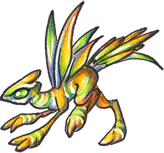
Kreenasa Dragonets are the most intelligent type of dragonet, and were developed by the Sharians. For the most part, their minds are similar to those of young human children, and they can learn simple concepts and follow instructions.
Dragonets can’t speak out loud, but they are able to speak mind-to-mind with their handler and anyone who happens to be nearby (not the most subtle form of communication if your dragonet is conveying something personal). They also vocalize with each other with various chirps, shrieks, and calls.
Rarity Major, common Size 6 inches to 3 feet long Origin Magically developed by the Sharians. Habitat Domesticated. Escaped Kreenasa Dragonets are unable to procreate in the wild as they require magical intervention to produce fertile eggs. Physical description Tiny dragons. Many have four legs and one pair of wings but this can vary widely. Other traits As Kreenasa Dragonets can be custom made by skilled Sharian mages, almost any trait is possible. Many traits are purely decorative. Typical coloration Any. Often bright colors. Reproduction Eggs, 1-3 per clutch Abilities Trainable (complex), broad mind speech, intelligent, flight (if winged). May have other abilities based on traits. Other N/A
Wild Dragonets 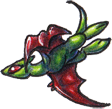
Wild Dragonets are one of the naturally-occurring dragonet species. They’re not as intelligent as Kreenasa Dragonets, more on par with a pet dog or cat, but they can still be trained to do various tasks. Wild Dragonets also cannot speak mind-to-mind, but they can learn verbal commands and have their own language of chirps, shrieks, and calls.Rarity Common Size 1 to 2 feet long Origin Naturally evolved Habitat Almost anywhere, as long as there is a source of food and water. Physical description Tiny dragons with one pair of clawed wings and one pair of hind legs. All have solid-colored eyes and ear nubs. Other traits If a Wild Dragonet has other traits as a result of magical altering or having a Kreenasa parent, it is considered a Kreenasa Dragonet. Naturally-occurring mutations are very rare. Typical coloration Colors that match their habitats, such as greens and browns for forest-dwellers and blues and purples for shore-dwellers. Reproduction Eggs, 1-3 per clutch Abilities Trainable (basic), flight. Other Wild Dragonets that live in areas with particularly cold winters generally hibernate through the winter.
Aquatic Dragonets – major, uncommon 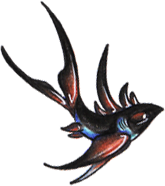
Unlike other dragonets, Aquatics are only able to breathe and live in the water. They communicate more with movements than noises, but can also create a series of clicks and shrieks under the water to make themselves heard. Aquatic Dragonets can only be equipped to aquatic Samanayrs.Rarity Uncommon Size 1 to 3 feet long Origin Naturally evolved Habitat Water, either fresh or salt. Physical description Small long and sleek dragons, with a variety of fins and flippers. Slitted gills on the neck. Other traits Tropical varieties tend to have more extravagant colors and fins. Typical coloration Any Reproduction Eggs, 1-3 per clutch Abilities Water breathing, trainable (basic). Other Can only be equipped by water-dwelling Samanayrs, as they are the only ones who can adequately communicate with them. All Aquatic Dragonets can live in either salt or fresh water, but most have a preference and will only reluctantly venture into the other type.
Catgryphs – major, uncommon 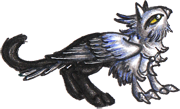
These cat-sized gryphons were also magically developed, with the hindquarters of a housecat and the forequarters of a bird. They’re still very cat-like in behavior and attitude, though perhaps a little more predatory. Although they are predators, they prey primarily on small rodents, insects, and fish. They can learn basic commands if their trainer is very dedicated.Rarity Uncommon Size 1 to 3 feet long Origin Magically developed, exact origin is unknown. Habitat Domesticated. Escaped Catgryphs are unable to procreate in the wild as they require magical intervention to produce young. Physical description Small gryphons with the forequarters and wings of a bird and hindquarters and ears of a housecat. Other traits Different ‘amounts’ of cat or bird can occur, resulting in features such as an entirely furred or feathered coat, front paws or rear talons, feathers on the tail, or an entirely bird-like tail. Typical coloration Natural cat and bird colors. Unnatural colors are very rare. Reproduction Live young, 1-2 per litter Abilities Trainable (basic), flight. Other N/A
Oquiesas – major, rare 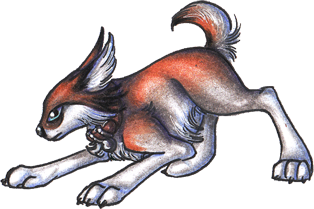
Oquiesas are canines that can vary in size from tiny to very large, and normally they’re the main predator of the Samanayrs. However, an Oquiesa raised from a pup and properly trained can become a Samanayr pet and protector. Finding Oquiesa pups in the wild can be very dangerous, but they’re also bred in captivity as pets.Oquiesas are as intelligent as dogs and usually respond well to training. They aren’t able to speak, but they can communicate through body language and their verbal language of barks, whines, and howls.
Rarity Rare Size 1 to 4 feet tall Origin Naturally evolved Habitat Almost anywhere, as long as there is a source of food and water. Physical description Dog-like canines with large, furred ears. Other traits Like dogs, Oquiesas can display a variety of different ear and tail types, body shapes, leg lengths, etc. Occasionally a mage will add traits such as horns or decorative wings. Typical coloration Natural canine colors. Unnatural colors are very rare. Reproduction Live young, 1-3 per litter. Abilities Trainable (complex), rideable (if large enough). Other Most domestic Oquiesas are bred by Sharians rather than Samanayrs. They have been working on their domestic lines for a number of years and a Sharian-bred Oquiesa is much more likely to take favorably to a Samanayr owner. Tragic accidents have occurred when an inexperienced Samanayr has tried to train a wild Oquiesa puppy themselves.
Oquiesas are meat eaters. If in an environment where wild game is not available, meat must be provided for them.
Firebirds – major, rare 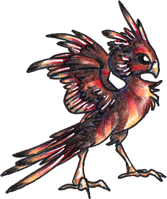
Firebirds are as intelligent as dragonets, easy to train and able to communicate with minor empathetic projection (eg their owner can feel how the Firebird is feeling if they concentrate hard enough). When angry or upset Firebirds can give off sparks, and they can briefly trail flame from the tips of their wing feathers as a territorial display. The flames they give off are magical in nature, pleasantly warm to the touch and not able to light other things on fire.Rarity Rare Size 10 inches to 2 feet tall Origin Magically developed by the Sharians. Habitat Temperate and tropical regions. If winters in the area are cold they will migrate to a warmer climate in the winter months. Physical description Birds that usually feature long tails and feathered crests. They have one pair of wings and one pair of taloned legs. Other traits Additional traits are usually feather-related, such as feather ‘ears’ or a particularly long feathered tail. Typical coloration Any Reproduction Eggs, 1-2 per clutch Abilities Empathic projection, magical flames/sparks, trainable (basic), flight.
Other N/A
Vairs – major, uncommon 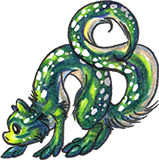
Vairs are less intelligent than dragonets, but can be trained to do simple tasks like retrieving small objects or doing basic tricks like rolling over, sitting, or playing dead. Because of their ability to squeeze through tight spots, they can also be trained to flush out vermin. More industrious owners can even train them to find treasure.
Rarity Uncommon Size 1 foot or less Origin Naturally evolved Habitat Primarily forested areas, sometimes grasslands. Physical description Long, colorful and very weasel-like creatures with upturned snouts and beady eyes. Other traits Ear length can vary and domestic Vairs can be bred without the upturned snout. They grow in length as they age. Typical coloration Wild Vairs’ coloring reflects their habitat, domestic Vairs can be more colorful. All have creamy undersides. Reproduction Live young, 1-3 per litter Abilities Trainable (basic) Other Created by Jaes, description by Jaes
Skedges – major, rare 
Skedges resemble a cross between hedgehogs and scarab beetles. Between their nose and antennae, skedges have an extremely keen sense of smell, and can be trained to find wild delicacies such as truffles, assist in search and rescues, or detect a number of different poisons in food or drink. They can also curl into a half-ball when threatened to try and protect their feet and stick their spines out further, though most think that they’re simply trying to be to cute to eat when doing so, rather than actually increasing their natural defenses.
Skedges’ armor plating and wings need to be shed and regrown every year. Molting takes about a month, during which time they live completely underground and feast off of their stored food from that year in order to grow as large as possible before their armor comes in. They’re very social with other skedges, and very unsocial with just about anything else, during this time, leading many owners to send their skedges to molting boarding schools for the month.
Rarity Rare Size 1 foot long. half-foot tall Origin Naturally evolved (magical influence) Habitat Primarily grasslands, sometimes deserts, forests, and rainforests. Physical description Hedgehog-like bodies with hard shells, transparent wings, spines along the sides, and armor on the face and underside. Other traits Males have horns of various shapes on their face plates. Typical coloration Hedgehog parts earthtones and neutrals, armor and shells colorful and shiny or metallic. Reproduction Live young (ked), 1 or 2 Abilities Trainable (basic) Other Created by Janalee, description by Janalee
Georoptors – major, rare 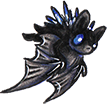
Georopters are small bat-like creatures with huge eyes and ears and stone deposits running down their backs. Georopters consume fruit and insects when the leave their caves at night, but they also mine the walls of their cave (usually by scratching and biting at the rock) for a specific mineral. What mineral/stone is unique to each colony of Georopters (can range anywhere from iron to precious gems like ruby, emerald, and diamond), and their bodies can distill the specific sought after mineral from the stone they eat, which then accumulates on their backs and can tint their fur. The oldest Georopters have thick layers of this stone, and their wings will gradually become stronger with age to compensate for the added weight.
Some colonies have also been known to eat the same glowing lichen that gives Illiayrs their glow, causing glowing eyes, claws, and mineral/gem deposits, though this isn’t common.
Giant Georopters (2′-3.5′ long) are extremely rare and highly valued, as they are large enough to be ridden by Samanayrs and are much easier to train. They are much more intelligent than smaller Georopters and can be trained as mounts for Riders.
Rarity Rare Size 6″ to 1′ long, Giants 2′-3.5′ long Origin Magically developed by the Sharians. Wild populations now exist. Habitat Mineral- and gem-rich caves/underground. Physical description Very similar to bats but with large eyes, vestigial noses, and mineral/gem deposits on back. Other traits Mineral deposits can glow if glowing lichen is consumed. Typical coloration Natural colors, any patterns, fur can also colored by their mineral/gem. Reproduction Live young, 1 or 2 Abilities Trainable (basic), flight. Can detect a vein of specific mineral/stone up to a foot and a half beneath the surface of a rock, and can be trained to look for a wide variety of them if trained young. Very difficult to train older ones to search for any stone but their own Other Created by Bluestarwolf12, description by Bluestarwolf12
Mage Constructs – major, rare 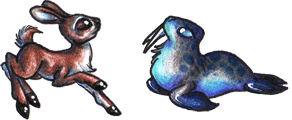
The Sharian, Kysian, and human mages in the Samanayr world are known for their experimentation with living things and magic, and this combination results in mage constructs. These are creatures with varying intelligence and features, anything from a mash-up of several different species to an animal with extra wings or appendages attached. Some of these constructs are more successful than others, and unfortunately there is the occasional abomination created.If a construct species becomes more established, it can become a species in its own right, but the first few individuals of a particular species will just be known as mage constructs. Many of them are breedable, but some types are sterile.
Rarity Rare Size Varies, usually on the small side (no more than 2 feet tall/long). Origin Magically created by Sharian, Kysian, and human mages. Habitat Varies depending on type. Physical description Varies widely. Other traits Varies widely. Almost anything animal-related is possible. Typical coloration Any Reproduction Live young or eggs, depending on type, 1-2 young/eggs. Abilities Varies widely. Other N/A
Avians – minor, common 
Birds of various types are available as pets. They vary widely in type, coloration, and features.Insects – minor, common 
‘Insects’ in this case is a very loose term, and can also apply to creatures such as scorpions and spiders.Fish – minor, uncommon 
Fish can only be equipped to aquatic Samanayrs!